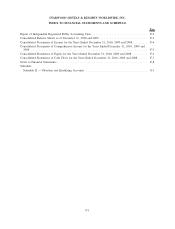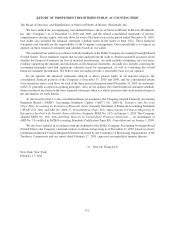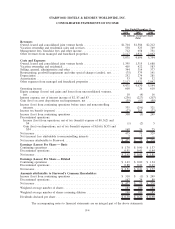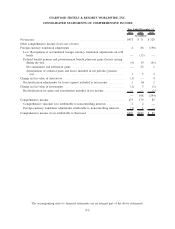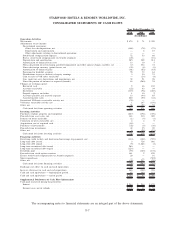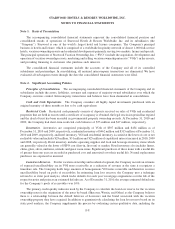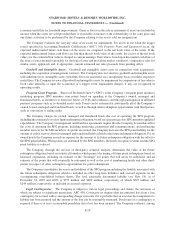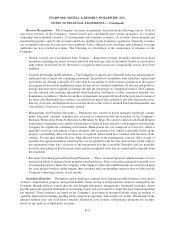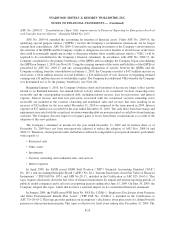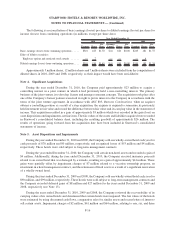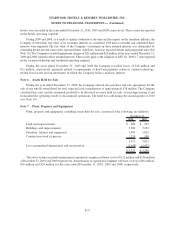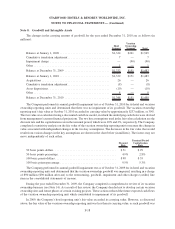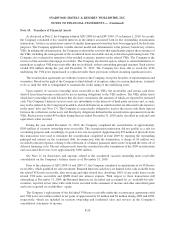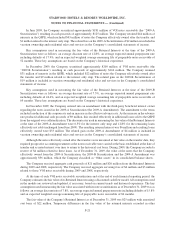Starwood 2010 Annual Report Download - page 127
Download and view the complete annual report
Please find page 127 of the 2010 Starwood annual report below. You can navigate through the pages in the report by either clicking on the pages listed below, or by using the keyword search tool below to find specific information within the annual report.other factors, the degree of probability of an unfavorable outcome and the ability to make a reasonable estimate of
the amount of loss. Changes in these factors could materially impact the Company’s financial position or its results
of operations.
Derivative Financial Instruments. The Company periodically enters into interest rate swap agreements,
based on market conditions, to manage interest rate exposure. The net settlements paid or received under these
agreements are accrued consistent with the terms of the agreements and are recognized in interest expense over the
term of the related debt.
The Company enters into foreign currency hedging contracts to manage exposure to foreign currency
fluctuations. All foreign currency hedging instruments have an inverse correlation to the hedged assets or liabilities.
Changes in the fair value of the derivative instruments are classified in the same manner as the classification of the
changes in the underlying assets or liabilities due to fluctuations in foreign currency exchange rates. These forward
contracts do not qualify as hedges.
The Company periodically enters into forward contracts to manage foreign exchange risk based on market
conditions. The Company enters into forward contracts to hedge fluctuations in forecasted transactions based on
foreign currencies that are billed in United States dollars. These forward contracts have been designated as cash
flow hedges, and their change in fair value is recorded as a component of other comprehensive income. As a
forecasted transaction occurs, the gain or loss is reclassified from other comprehensive income to management fees,
franchise fees and other income.
The Company does not enter into derivative financial instruments for trading or speculative purposes and
monitors the financial stability and credit standing of its counterparties.
Foreign Currency Translation. Balance sheet accounts are translated at the exchange rates in effect at each
period end and income and expense accounts are translated at the average rates of exchange prevailing during the
year. The national currencies of foreign operations are generally the functional currencies. Gains and losses from
foreign exchange and the effect of exchange rate changes on intercompany transactions of a long-term investment
nature are generally included in other comprehensive income. Gains and losses from foreign exchange rate changes
related to intercompany receivables and payables that are not of a long-term investment nature are reported
currently in costs and expenses and amounted to a net gain of $39 million in 2010, a net gain of $6 million in 2009
and a net gain of $5 million in 2008.
Income Taxes. The Company provides for income taxes in accordance with ASC 740, Income Taxes. The
objectives of accounting for income taxes are to recognize the amount of taxes payable or refundable for the current
year and deferred tax liabilities and assets for the future tax consequences of events that have been recognized in an
entity’s financial statements or tax returns.
Deferred tax assets and liabilities are measured using enacted tax rates in effect for the year in which those
temporary differences are expected to be recovered or settled. The effect on deferred tax assets and liabilities of a
change in tax rates is recognized in earnings in the period when the new rate is enacted.
Stock-Based Compensation. The Company calculates the fair value of share-based awards on the date of
grant. Restricted stock awards are valued based on the share price. The Company has determined that a lattice
valuation model would provide a better estimate of the fair value of options granted under its long-term incentive
plans than a Black-Scholes model. The lattice valuation option pricing model requires the Company to estimate key
assumptions such as expected life, volatility, risk-free interest rates and dividend yield to determine the fair value of
share-based awards, based on both historical information and management judgment regarding market factors and
trends. The Company amortizes the share-based compensation expense over the period that the awards are expected
to vest, net of estimated forfeitures. If the actual forfeitures differ from management estimates, additional
adjustments to compensation expense are recorded. Please refer to Note 23, Stock-Based Compensation.
F-11
STARWOOD HOTELS & RESORTS WORLDWIDE, INC.
NOTES TO FINANCIAL STATEMENTS — (Continued)


